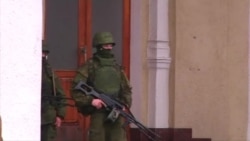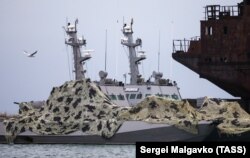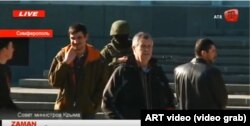Russia formally annexed the Crimean peninsula from Ukraine on March 18, 2014, and the date March 18 took on added significance in Russia. It was chosen for Russia’s 2018 presidential election, possibly to remind voters of President Vladimir Putin’s “achievement.” The annexation of Crimea -- or “reunification,” as the Kremlin portrays it -- gave Putin skyrocketing approval ratings for several years. But since 2018, Putin’s rating has sunk to pre-annexation levels, and thus it is fitting to reflect on some of the most common pieces of disinformation about the annexation of Crimea.
Little Green Men
The Crimean annexation began -- at least as seen from the outside -- with the appearance of what Ukrainians would call the “Little Green Men.” These were soldiers outfitted with the latest Russian uniforms and gear, but without identifying insignia, who fanned out across the peninsula in late February 2014. Putin denied that the men were Russian military personnel, and officially it was claimed that these were pro-Russian “self-defense militias” formed by local citizens. Yet these heavily armed units, equipped with armored personnel carriers, managed to secure and blockade Ukrainian military installations across the peninsula. Most importantly, they seized the Crimean parliament building in Simferopol, where the crucial vote to have a referendum would take place. After the hastily organized referendum was completed and Russia formally annexed the peninsula (which most countries still recognize as part of Ukraine), Putin admitted that the “self-defense militias” had actually been Russian troops.
The “Referendum” and the “Will of the Crimean People”
When challenged on the legitimacy of the Crimean annexation, Russian officials and state media claimed that the “reunification” was the “will of the Crimean people,” and an act of “self-determination” and “historical justice.” However, the Crimean “referendum” was not conducted in a legal or transparent way, and evidence suggests that only a minority of Crimean residents actually voted.
After Russian forces took over the Crimean parliament, they gathered lawmakers to organize the referendum, which violated Ukraine’s constitution. The only election observers to monitor the referendum were handpicked by Russia: most of them belonged to European fringe parties sympathetic to Russia. The Organization for Security and Co-operation in Europe (OSCE), which conducts real election monitoring, declared the referendum “illegal.” The United Nations General Assembly adopted a resolution stating the referendum had “no validity.”
Because of the lack of impartial observers to monitor the vote, it’s impossible to verify that a majority of Crimean residents voted for secession from Ukraine and for unification with Russia. While Russia’s official sources claim 96.77% were in favor with a turnout of 83.1%, other estimates were much lower. For example, the Russian Presidential Council for Human Rights reported in April 2014 that real turnout was between 30-50%, and that 50-60% of those participants voted in favor secession from Ukraine and unification with Russia. On top of this, there were allegations of vote rigging.
When discussing Crimea, Putin and Russian officials often bring up Kosovo, whose independence is recognized by the United States and European Union countries, among others. The Russians point to NATO’s use of military force against the Serbian government of Slobodan Milosevic. In 2008, Kosovo unilaterally declared independence from Serbia. While the cases of Crimea and Kosovo are not as analogous as the Kremlin claims, it is worth noting that Russia still does not recognize Kosovo as an independent state, at the same time demanding that the world recognize Crimea as Russian.
Escalation in 2018
The drama in Crimea didn’t end after 2014. On November 25, 2018, Russian coast guard vessels attacked a convoy of three Ukrainian naval ships that were attempting to transit the Kerch Strait into the Sea of Azov. All three ships were captured and their crews are currently imprisoned in Russia, where they are being charged for violating Russia’s borders. As with the annexation of Crimea, disinformation was deployed from the beginning to justify the aggressive actions at sea.
First, the Russian side claimed that the Ukrainian ships were in its territorial waters when they were attacked. Subsequent investigations found that the vessels were actually in international waters when the incident occurred. Second, a bilateral treaty between Ukraine and Russia was still in effect at the time, guaranteeing free passage through the strait and in the Sea of Azov to naval and commercial vessels of both countries. President Putin himself made a number of false claims about the incident. On one occasion he falsely claimed that the Ukrainian vessels Russia captured had been gifted to the Ukrainian navy by the U.S.
Well before the Kerch Strait attack, the EU’s Disinformation Review reported that a Russian disinformation campaign concerning the Azov Sea was already underway. That campaign included a claim in September 2017 that Ukraine was deepening the seabed for a non-existent NATO fleet; another claim, made without evidence in September 2018, that Ukraine had infected the Azov Sea with cholera; and a third, made in October 2018, that the U.S. had for years been planning for clashes between Russian and Ukrainian naval ships.
Conditions in Crimea
The main victims of Russia’s annexation of Crimea are the Crimean Tatars, who were deported en masse from the peninsula by the Soviet government in 1944 and who gradually returned there following the death of Josef Stalin. In March 2014, Reshat Ametov, a Tatar activist who took part in a protest against Russia’s occupation of Crimea, disappeared, only to be found dead with signs of torture and trauma on his body. By 2017, the human rights group Amnesty International counted 70 Crimean Tatar activists who had been prosecuted for engaging in peaceful, often one-person protests.
Russian authorities have also charged and convicted a number of Ukrainians under suspicious circumstances. These include film director Oleh Sentsov, as well as Volodymyr Balukh, who first came under police scrutiny because he’d flown a Ukrainian flag from his house after the annexation of Crimea. What is more, the application of Russian law in Crimea has criminalized other groups that were previously legal. For example, Opioid Substitution Therapy (OST) for drug addicts is legal in Ukraine but not in Russia, meaning organizations providing this treatment have come under threat since the annexation. Religious organizations that are banned in Russia have also found themselves targeted in Crimea, one recent example being the Jehovah’s Witnesses.
In the five years since Russia annexed Crimea, Putin and other Russian officials have repeated various lines of disinformation about Crimea. The main recurring themes are that the annexation of the peninsula was a democratic expression of self-determination on the part of the Crimean population. In fact, the annexation had a lot more to do with the actions of the Russian military, whose presence Putin denied until the peninsula was under his control.








